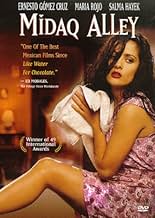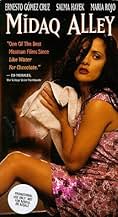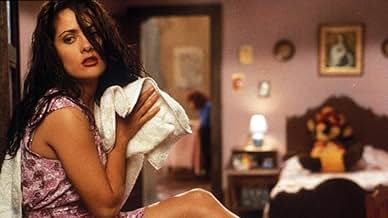NOTE IMDb
7,3/10
3,5 k
MA NOTE
Ajouter une intrigue dans votre langueThe lives of men and women living on Callejón de los Milagros in Mexico City.The lives of men and women living on Callejón de los Milagros in Mexico City.The lives of men and women living on Callejón de los Milagros in Mexico City.
- Réalisation
- Scénario
- Casting principal
- Récompenses
- 27 victoires et 13 nominations au total
Avis à la une
Naguib Mahfouz, the Egyptian novelist, whose "Midaq Alley" serves as the basis of this film, wrote about the characters that populate that narrow strip of an Egyptian city, and how in some ways, all of their lives are so inter-connected to one another.
Director Jorge Fons and the adapter, Vicente Lenero, transferred the action to Mexico City. They used the same format that Alejandro Gonzalez Inarritu later used for his successful "Amores Perros" in 2000. It would be unfair to compare both films, yet, one can see certain parallels in the way the films unfold. Each narrative shows exact moments in which the lives of the people that part of town prove pivotal for the stories presented in the film.
There are four stories in the film. Each deals with what happened to that particular character while all have points in which they connect with the others. The film shows that when Mexican filmmakers want to tell interesting human stories, such as the ones depicted in the film, they don't have a thing to envy to the best types of cinema of the world. This is clearly a movie that will survive because of its universal themes.
Salma Hayek was making her second appearance in front of the cameras. She proved why she was an actress to be reckoned with. Her Alma shows a vulnerability, and freshness as she approaches the character. Ernesto Gomez Cruz, Maria Rojo, Bruno Bichir, Daniel Gimenez Cacho, Luis Felipe Tovar and the rest of the cast do excellent ensemble work under Mr. Fons direction.
The film will not disappoint the viewer.
Director Jorge Fons and the adapter, Vicente Lenero, transferred the action to Mexico City. They used the same format that Alejandro Gonzalez Inarritu later used for his successful "Amores Perros" in 2000. It would be unfair to compare both films, yet, one can see certain parallels in the way the films unfold. Each narrative shows exact moments in which the lives of the people that part of town prove pivotal for the stories presented in the film.
There are four stories in the film. Each deals with what happened to that particular character while all have points in which they connect with the others. The film shows that when Mexican filmmakers want to tell interesting human stories, such as the ones depicted in the film, they don't have a thing to envy to the best types of cinema of the world. This is clearly a movie that will survive because of its universal themes.
Salma Hayek was making her second appearance in front of the cameras. She proved why she was an actress to be reckoned with. Her Alma shows a vulnerability, and freshness as she approaches the character. Ernesto Gomez Cruz, Maria Rojo, Bruno Bichir, Daniel Gimenez Cacho, Luis Felipe Tovar and the rest of the cast do excellent ensemble work under Mr. Fons direction.
The film will not disappoint the viewer.
A film of surprising depth and frankness, this is no Mexican soap opera. The film is told in chapters, one about each major character. They all come from the same neighborhood and their lives intertwine. For the most part the stories wind up in disappointment, with few moments of sweetness, and some real tragedies. It's not quite a slice of life, but compares very favorably to the similar American film Short Cuts by Robert Altman. Without going into too much detail, it follows a late mid-life 'crisis' of a bar owner named Rutilio who finally allows his inner yearnings to surface, almost at the cost of his family. The second chapter follows Alma (Salma Hayek, the only recognizable name from the cast) as a lovely ghetto girl who is torn by the absence of her fiance who is in America and the desires, needs and temptations of being young, lovely, and inexperienced. The third chapter is about Susanna, the local landlord, middle-aged, homely, and never-been-loved and the trials she puts herself through after a fateful tarot-card reading predicting the imminent appearance of a man in her life. The last chapter, the Return, ties all the strings together as best they can be, because this is life and the strings simply don't tie together that well.
I didn't expect a Mexican film of this frankness - not just sex, but characters having real conversations, smoking grass, getting mixed up in an underworld with a sheen of decency and the expected rotten core - all rotating around the table in the neighborhood bar where the men play dominoes. These comments may not have convinced you to see this movie, but if you did see and liked Short Cuts then I highly recommend this film. And if Short Cuts is gobbledegook to you then I recommend both. Nine out of Ten.
I didn't expect a Mexican film of this frankness - not just sex, but characters having real conversations, smoking grass, getting mixed up in an underworld with a sheen of decency and the expected rotten core - all rotating around the table in the neighborhood bar where the men play dominoes. These comments may not have convinced you to see this movie, but if you did see and liked Short Cuts then I highly recommend this film. And if Short Cuts is gobbledegook to you then I recommend both. Nine out of Ten.
The movie Midaq Alley follows different characters to show everyday life for a small community in Mexico while the viewer sees the same story from a different perspective. I think the same scene placed at the beginning of each synopsis that shows some older men playing dominoes in Don Ru's cantina is symbolic because it is representative of an ordinary day and also shows how people in the community gather together and share stories and get to know one another. I feel that it represents the culture in Mexico and emphasizes how everyone looks out for one another, like how Ubaldo looks out for Eusebia's sadness and how Dona Cata looks out for Susanita's feelings, and also how Abel looks out for Chava's well being. By making this scene the establishing shot for each time the viewer sees a different point of view begin, the director is trying to portray how significant gathering for a game of Dominos in the cantina is in the daily lives of those in Midaq Alley. There are also some street scenes where it seems everyone knows one another. I wonder if it is a custom to be so close to neighbors and care for them like family, or if it has to do with the small size of their community. I was not really surprised that the ending was not extremely dramatic. I think it was very fitting to leave things the way they were because the movie was a portrayal of everyday life. I feel that the scenes of the men playing Dominos at Don Ru's cantina are the most important scenes of the film because it tells the viewer that although the characters presented have complex lives, the actions they take to reach their individual happiness are mundane when you take a look at the bigger picture, especially when you realize the men playing dominoes are older and have gone through many life experiences, perhaps they are trying to tell us to relax and not take life so seriously.
10pilot19
This story demonstrates the intertwined and tragic minutia of common folks told in a dramatic and realistic format. The ensemble cast members are at ease with one another as they display acts of beauty and brutality. The theme of love unfolds from the neophyte, to the jaded, to the unabashed. The actors appear natural and believable (unlike some Latin "novelas"), developing their characters in a seamless and effortless fashion. The devotion to cultural stereotypes only lends credibility to the story's environment and development. The attention to detail (Susanita's teeth for example); make the characters as believable and endearing as any in recent memory. This movie is a brilliant look at human tragedy. Watching it with someone you love only makes it more moving and poignant. Excellent!!!
This movie is an impressive and exciting story about the people,their feelings,love,desperation,anger and hope.Although the scenario is a little bit melodramatic , the film is a must indeed.It is quite different from the blockbusters with happy ends because it is real and outstanding.Several lives and fates are mixed in it.Every character has their own unique personality.They all have to take decisions for their lives and have to fight for happiness.The actors are very nice.The stunning Hayek makes a good performance .Gomes Krus is also convincing as a man who becomes gay after 30 years marriage.The supporting roles are also well-played.Don't think that this is some kind of soap opera- it is something deeper...
Le saviez-vous
- AnecdotesVeronica Falcón's debut.
- ConnexionsFeatured in Cuba mon amour (1997)
Meilleurs choix
Connectez-vous pour évaluer et suivre la liste de favoris afin de recevoir des recommandations personnalisées
- How long is Midaq Alley?Alimenté par Alexa
Détails
- Durée
- 2h 20min(140 min)
- Couleur
- Mixage
- Rapport de forme
- 1.85 : 1
Contribuer à cette page
Suggérer une modification ou ajouter du contenu manquant


































